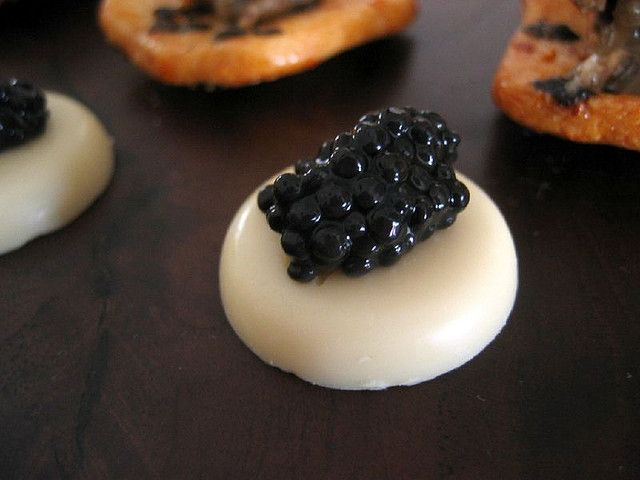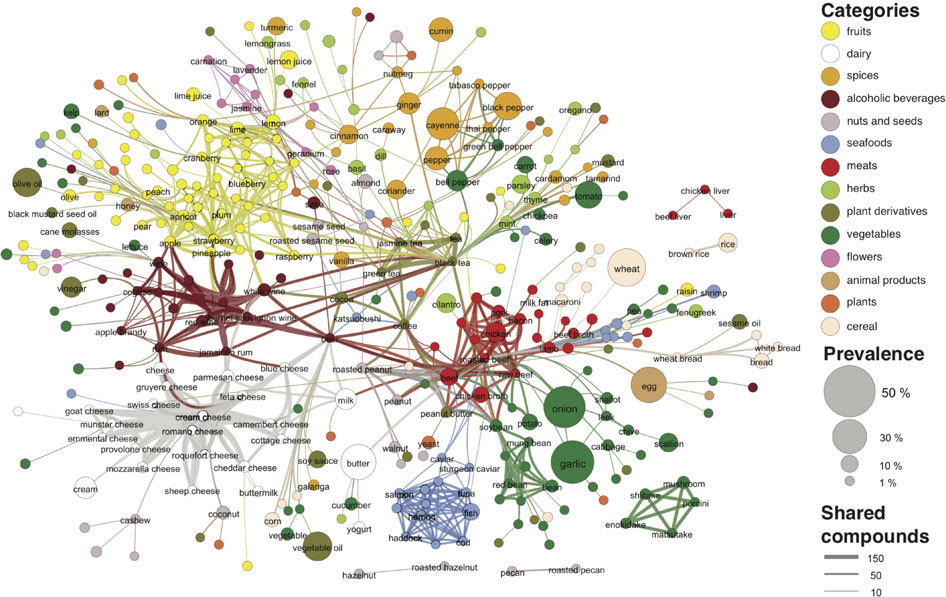BY: MEGAN LOW
Confession: I’ve been indulging in a little too much viewing of the popular show MasterChef recently. One thing that never fails to have me in awe and equal bewilderment is how the judges can instantly tell that cranberries in a risotto won’t work before tasting it. I mean, I’ve heard of weirder food combinations that are actually a thing… like, Caviar and white chocolate?

Figure 1. White chocolate caviar
Despite how much it sounds like it wouldn’t work, it apparently does in the culinary world. Maybe some foods are a pre-match made in heaven – like the more widely known tomato and basil, or peanut butter and chocolate!
So herein lies my question: are we programmed to enjoy certain flavors together?
But first, what is flavor?
Not to be mistaken as the same thing, taste is solely detected by the gustatory system (which encompass the basic tastes i.e, sweet, salty, bitter, sour, umami and now, fat). On the other hand, flavor is a combination of taste, trigeminal sensations (like spiciness or pungency) that stimulate a cranial nerve and, largely, aromas detected by olfaction (1, 2). Texture, sound and color are other non-chemical factors that can additionally influence how we perceive flavor (3).
The big player: aromatics
A gas chromatogram would reveal possibly hundreds of volatile aromatic compounds in a food; but of those only a few make up the characteristic flavors to which we are accustomed. For example, strawberry flavor is made up of 350 volatile compounds. But of those 350 compounds, esters like methyl butanoate, ethyl butanoate, butyl butanoate, methyl hexanoate, ethyl hexanoate, butyl acetate and hexyl acetate mainly contribute to its signature fruity aroma (4). Another example is how the characteristic smell and flavor of bananas are due primarily to isoamyl acetate, even though it contains about 250 volatile constituents (5).

Figure 2. Gas chromatogram of strawberry volatiles
What makes flavors pair well?
Similarity in aromatic compounds are often cited as the reason behind the marriage of certain flavors. White chocolate and caviar are said to go well together because they share the compound trimethylamine. To test this hypothesis, scientists generated a flavor map showing the prevalence of shared flavor compounds between different foods, which The Scientific American reproduced an interactive version of (6)! It might be worth using that to experiment with food pairings in your own kitchen!

Figure 3. Interaction Flavor Map
 Figure 4. A flavor chart illustrating the shared aromatic compounds between different foods
Figure 4. A flavor chart illustrating the shared aromatic compounds between different foods
Using a database of recipes and flavor compounds, Ahn et al. showed that ingredient pairings in Western cuisine do share similar flavor compounds. However, interestingly, they found the opposite with East Asian cuisine (2).
While it may be true that similar flavor compounds play a role in good pairing, we judge our food by many other aspects, including a balance of intensity of flavors or between tastes like sweet-sour (7). Eschevins et al.’s study is a good example. Despite the fact that their results supported this aromatic similarity principle, it was noted that not all participants scored the similar pairings higher as they could be judging based on other criteria such as intensity balance, which may not have been replicated in every pairing (8). Take a favorite of mine for example: maple bacon donuts. Who would’ve thought that fried, fatty bacon would find residence atop a sugary dessert? The balance of saltiness, sweetness and smokiness somehow works. Don’t forget that a blend of textures contribute to a desirable mouthfeel too. The crunch of almonds both contrast and complement velvety ice cream, while the crisp caramelized layer of a creme brulee is savored against that warm custard.

Figure 5. Maple bacon donuts
Flavor preference can further be influenced by things like culture and exposure. I enjoy the combination of a crunchy-on-the-outside-soft-on-the-inside, sweet-salty deep fried pumpkin in salted egg (a novel street food in Malaysia that has gained popularity over the years), while to Americans, that may sound odd and think pumpkin is best with good ol’ pumpkin pie spice. Or how some like their tea with milk in Hong Kong while others in India drink chai with cloves or cardamom. The more a person is exposed to a flavor, the more likely the person is to grow up liking or at least, accepting it.

Figure 6. Deep fried salted egg yolk pumpkin
Conclusion
If you think about it, a preference of sweetness and a disdain for bitterness (taste) is pretty much universal – across cultures and even age groups (9). But when it comes to flavor, so many elements suddenly come into play since flavor is multimodal. Furthermore, our perception of flavor is subjective and quantitative methods sometimes only tell us so much. For example, a gas chromatogram can show us the volatiles that are present in the food matrix, but smelling them requires these volatiles to be released from the matrix and diffused into the environment, which can be affected by things like the compound’s molecular weight, polarity, functional groups, the structure of the food matrix, and temperature (1). Not all volatiles present are able to interact human olfactory receptors (5). In other words, chromatogram peaks may not be representative of what we actually perceive. Therefore, when quantifying volatiles, qualitative information is also equally needed to characterize these compounds.
As Morten Paulsen and his co-workers puts it best: the nature of interactions between food is highly complex, making it hard to establish a universal guideline for good pairings. Forget the rules – what are your favorite food pairings then?
References
- Sanchez-Rodriguez L. et al. (2019). Chapter 18 – Flavors and Aromas. In E. Yahia, Postharvest Physiology and Biochemistry of Fruits and Vegetables. pp. 385-404. Woodhead Publishing. Retrieved from https://doi.org/10.1016/B978-0-12-813278-4.00019-1
- Ahn Y, Ahnert S, Bagrow J, & Barabási A. (2011). Flavor network and the principles of food pairing. Scientific Reports, 1(196), 1-7. doi: 10.1038/srep00196.
- Thomas-Danguin T. et al. 2016. 5 – Multimodal interactions. In Etiévant P. et al., Flavor. pp. 121-141. Woodhead Publishing. Retrieved from https://doi.org/10.1016/B978-0-08-100295-7.00006-2
- Urrutia M, Rambla J, Alexiou K, Granell A, & Monfort A. (2017). Genetic analysis of the wild strawberry (Fragaria vesca) volatile composition. Plant Physiology And Biochemistry, 121, 99-117. doi: 10.1016/j.plaphy.2017.10.015
- Pino J, & Febles Y. (2013). Odour-active compounds in banana fruit cv. Giant Cavendish. Food Chemistry, 141(2), 795-801. doi: 10.1016/j.foodchem.2013.03.064
- Moyer M, & Tulp JW. (2013). The Flavor Connection [Interactive]. Retrieved from https://www.scientificamerican.com/article/flavor-connection-taste-map-interactive/
- Paulsen M, Rognså G, & Hersleth M. (2015). Consumer perception of food–beverage pairings: The influence of unity in variety and balance. International Journal Of Gastronomy And Food Science, 2(2), 83-92. doi: 10.1016/j.ijgfs.2014.12.003
- Eschevins, A., Giboreau, A., Allard, T., & Dacremont, C. (2018). The role of aromatic similarity in food and beverage pairing. Food Quality And Preference, 65, 18-27. doi: 10.1016/j.foodqual.2017.12.005
- Prescott, J. (2013). Taste Matters. London: Reaktion Books.






Food is so much more. Thank you for this article as I have just remembered that food is more of a science and that I have so much to learn …